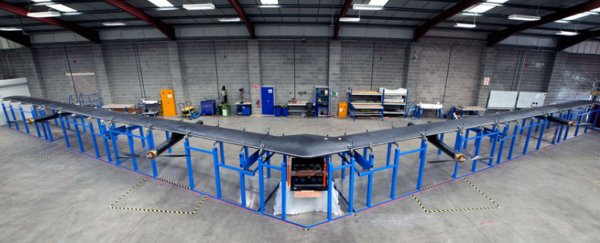Facebook is getting ready to beam Internet signals down from the sky with a high-flying drone aircraft, in an ambitious plan that comes across like a high-tech reimagining of an H.G. Wells novel.
The company announced this week that a full-scale prototype of its Aquila drone is now complete and ready for flight-testing. Resembling a sleek V-shaped stealth bomber, the aircraft is designed to fly at high altitudes for long periods of time, sending Internet signals down to remote areas that don't have conventional access to the Web.
The full-size craft might look slight in pictures, but it's actually pretty massive, with a wingspan of 42 metres putting it in the same league as a Boeing 737. Facebook points out, however, that Aquila's design and lightweight carbon-fibre frame means it actually weighs hundreds of times less.
The aircraft is designed to fly at altitudes above commercial airspace, between 18 metres and 27 kilometres above the ground, and when Facebook describes the drone as "long-endurance", it's not kidding: the solar-powered Aquila can circle in the sky for up to 90 days before needing to land.
The drones are designed to receive a radio Internet signal from a distant ground station, which can then be shared between drones using a network of drone-to-drone lasers in addition to beaming the signal down to remote communities on the ground.
The laser technology is something that Facebook researchers have also been working on. The company says it has achieved a major breakthrough: lasers capable of beaming tens of gigabits of data per second, which it claims is 10 times the current state of the art. They're precise too, supposedly able to target an area the size of a coin from hundreds of kilometres away.
The initiatives are part of Facebook's Connectivity Lab, working in conjunction with the company's non-profit enterprise Internet.org, the goal of which is to improve Internet access around the globe. With 4 billion people on the planet not having access to the Web, it's a big job, not helped by the fact that 10 percent of the world's population lives in remote areas that don't have any Internet infrastructure to begin with.
Facebook says it's not planning on operating its own drone network to solve the problem, but has developed the Aquila as a demonstration of what's possible in the hope that other companies will deploy similar technologies.
The Aquila project draws parallels with another highly publicised effort to provide Internet to remote areas: Google's Project Loon. Google's vision is similar to Facebook's drone plan but uses an alternative form of aircraft to deliver the signal: hot-air balloons. H.G. Wells would most certainly approve!
Google's technology is further along than Facebook's research, with the search giant having just inked a deal with Sri Lanka to douse the island in broadband and make it the first country in the world to enjoy universal Internet coverage.
Take a look inside Facebook's Connectivity Lab - an important part of our effort to bring connectivity to the billions of people who are unconnected today.
Posted by Facebook Engineering on Thursday, July 30, 2015
